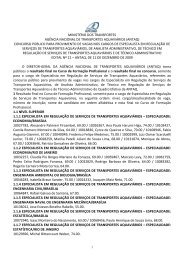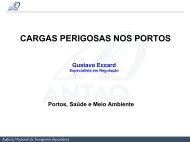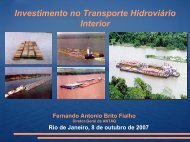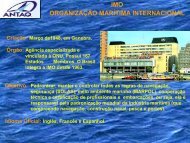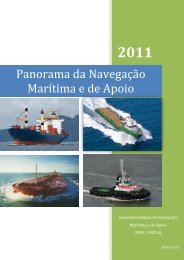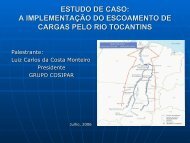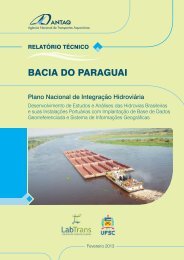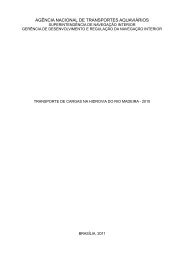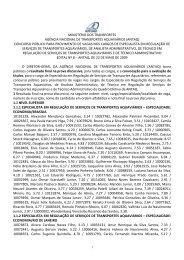Waterway Panorama - Antaq
Waterway Panorama - Antaq
Waterway Panorama - Antaq
You also want an ePaper? Increase the reach of your titles
YUMPU automatically turns print PDFs into web optimized ePapers that Google loves.
l <strong>Waterway</strong> <strong>Panorama</strong><br />
Solid waste<br />
Solid waste is also entering a new phase with<br />
the review of the RDC 217 of the National<br />
Health Surveillance Agency (ANVISA). The<br />
promulgation of the RDC 056/08 brought a new<br />
concept of good environmental practices for<br />
waste. As in other legislation texts (the same subject<br />
is treated as a Plan of Waste, such as Law<br />
9,966/00), the correct understanding of this provision<br />
is necessary.<br />
Good environmental practices for collection<br />
and disposal of waste should be achieved by organized<br />
ports and other facilities, regardless of<br />
formal plans. The question still faces regulations<br />
with different determinations established by AN-<br />
VISA and the International System of Agricultural<br />
Surveillance (VIGIAGRO).<br />
It is important that the proper treatment be<br />
given to facilitate destination, which should happen<br />
after autoclaving in the primary zone, as required<br />
by the VIGIAGRO. The use of autoclaves<br />
meets the elimination or exclusion of incinerated<br />
waste in port areas, for the high environmental<br />
impact they cause.<br />
Licensing process<br />
It is a process of great relevance to port activities<br />
and, therefore, should be built within<br />
an understanding of environmental logic. To<br />
this end, it is essential review prior licensing<br />
and its environmental impact assessments.<br />
By design, prior licensing for undertakings is<br />
a license of decision, that is, the environmental<br />
possibility to implement the undertaking, where<br />
it is designed, is taken into consideration. Environmental<br />
impact assessments should meet<br />
the demand for the assessment alone, as it is<br />
relevant to the decision-making process. In the<br />
current licensing practice, this does not happen<br />
that way. The environmental impact assessment,<br />
EIA is nearly always, unnecessarily, a<br />
prospective study of possible impacts. Therefore,<br />
it has impacts of little relevance, liable to<br />
well-known, technically manageable processes<br />
of minimization.<br />
These normal impacts, which may be adequately<br />
minimized, should not be part of this<br />
assessment. They should rather be part of the<br />
executive project for installation licensing, providing<br />
time to the environmental licensing<br />
agency. This is an unnecessary social burden<br />
that may be easily resolved.<br />
A major flaw of our clearance process is<br />
that environmental impact assessments, even in<br />
its current form, should generate management<br />
indicators of the environments to which they relate,<br />
for the undertaking they enable. Being so<br />
complex and extensive, they never reach their<br />
goal and generate more confusion than knowledge<br />
about the impacting forces they are supposed<br />
to map.<br />
60



